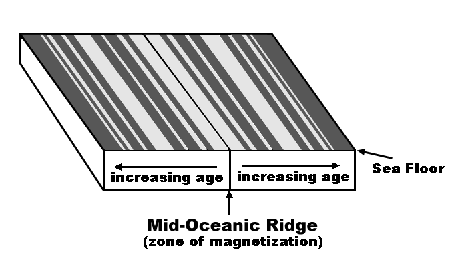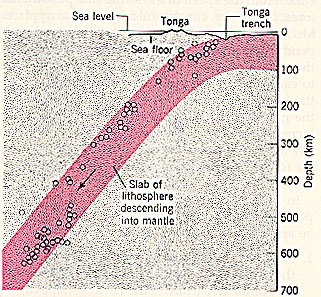
Plate Tectonics Basics
The main features of plate tectonics are:
A)
The Earth's surface is covered by a series of
crustal plates.
B) The ocean floors are continually, moving, spreading from the center,
sinking at the edges, and being regenerated.
C) Convection currents beneath the plates move the
crustal plates in
different directions.
D) The source of heat driving the convection currents is radioactivity
deep in the Earth's mantle.
Advances in sonic depth recording during World War II and the subsequent development of
the nuclear resonance type magnetometer (proton-precession magnetometer) led to detailed
mapping of the ocean floor and with it came many observation that led scientists like
Howard Hess and R. Dietz to revive Holmes' convection theory. Hess and Dietz modified the
theory considerably and called the new theory "Sea-floor Spreading". Among the
seafloor features that supported the sea-floor spreading hypothesis were: mid-oceanic
ridges, deep sea trenches, island arcs, geomagnetic patterns, and fault patterns.
Mid-Oceanic Ridges
The mid-oceanic ridges rise 3000 meters from the ocean floor and are more than 2000
kilometers wide surpassing the Himalayas in size. The mapping of the seafloor also
revealed that these huge underwater mountain ranges have a deep trench which bisects the
length of the ridges and in places is more than 2000 meters deep. Research into the heat
flow from the ocean floor during the early 1960s revealed that the greatest heat flow was
centered at the crests of these mid-oceanic ridges. Seismic studies show that the
mid-oceanic ridges experience an elevated number of earthquakes. All these observations
indicate intense geological activity at the mid-oceanic ridges.
Geomagnetic Anomalies
Periodically, the Earth's magnetic field reverses. New rock formed from magma
records the orientation of Earth's magnetic field at the time the magma cools. Study of
the sea floor with magnetometers revealed "stripes" of alternating magnetization
parallel to the mid-oceanic ridges. This is evidence for continuous formation of new rock
at the ridges. As more rock forms, older rock is pushed farther away from the ridge,
producing symmetrical stripes to either side of the ridge.
 |
In the diagram to the left, the dark stripes represent ocean floor generated during "reversed" polar orientation and the lighter stripes represent the polar orientation we have today. Notice that the patterns on either side of the line representing the mid-oceanic ridge are mirror images of one another. The shaded stripes also represent older and older rock as they move away from the mid-oceanic ridge. Geologists have determined that rocks found in different parts of the planet with similar ages have the same magnetic characteristics. Recognizing these anomalies and interpreting them in terms of new sea floor generation at mid-oceanic ridges was one of the key elements for the formulation of the plate tectonics theory. |
Deep Sea Trenches
The deepest waters are found in oceanic trenches, which plunge as deep as 35,000
feet below the ocean surface. These trenches are usually long and narrow, and run parallel
to and near the oceans margins. They are often associated with and parallel to large
continental mountain ranges. There is also an observed parallel association of trenches
and island arcs. Like the mid-oceanic ridges, the trenches are seismically active, but
unlike the ridges they have low levels of heat flow. Scientists also began to realize that
the youngest regions of the ocean floor were along the mid-oceanic ridges, and that the
age of the ocean floor increased as the distance from the ridges increased. In addition,
it has been determined that the oldest seafloor often ends in the deep-sea trenches.
rocks.
 |
The observation that earthquakes associated with deep sea trenches fall onto an inclined plane that can be interpreted as a descending piece of ocean crust (Benioff Zone) is another important piece of evidence for the plate tectonics theory. The earthquakes are generated as the descending slab of ocean crust interacts (friction) with the surrounding mantle. The picture to the left shows earthquake locations along the Tonga Trench, where the Pacific plate is currently being subducted underneath the Tonga island arch. |
Island Arcs
Chains of islands are found throughout the oceans and especially in the western
Pacific margins; the Aleutians, Kuriles, Japan, Ryukus, Philippines, Marianas, Indonesia,
Solomons, New Hebrides, and the Tongas (above), are some examples.. These "Island
arcs" are usually situated along deep sea trenches and are situated on the
continental side of the trench.
These observations, along with many other studies of our planet, support the theory that
underneath the Earth's crust (the lithosphere: a solid array of plates) is a malleable
layer of heated mantle rock known as the asthenosphere (sphere of weakness) which is
heated by radioactive decay of elements such as Uranium, Thorium, and Potassium. The
"weakness" of the asthenoshpere is due to its high temperature (just like a
glowing nail lacks the strength of a nail at room temperature) and due to the likelihood
that small portions of it (a few %) are actually molten (melt mixed with mineral grains).
In a physical sense the asthenosphere and possibly the mantle as a whole, can be
considered a liquid/fluid of very high viscosity (flows very slowly). Because the
radioactive source of heat is deep within the mantle, the "fluid" asthenosphere
circulates as convection currents underneath the solid lithosphere.

This animation shows how the hot silicate rock of the Earth's mantle is stirred by heat trying to escape. The heat is generated by the radioactive decay of natural elements like uranium. The hot rock (yellow) rises slowly as the denser cold rock (blue) sinks. The layer is at least 700 km thick, and could be as thick as 2900 km. The rock is at temperatures of order 1000 to 2000°C and creeps like a very viscous fluid. Its viscosity is about 20 orders of magnitude greater than that of water so velocity is only centimeters per year, and the time interval of this animation is on the order of 10 million years or more. (If necessary, hit reload to activate animation).
This heat that drives mantle convection is also the source of lava we see in volcanoes, the source of heat that drives hot springs and geysers, and the source of raw material which pushes up the mid-oceanic ridges and forms new ocean floor.
 |
Magma continuously wells upwards at the mid-oceanic ridges and generates the forces that pull the sea floor apart at the mid-oceanic ridges. As the ocean floor is spread, apart cracks appear in the middle of the ridges allowing molten magma to surface through the cracks to form the newest ocean floor. As the ocean floor moves away from the mid-oceanic ridge it will eventually come into contact with a continental plate and will be subducted underneath the continent. Finally, the lithosphere will be driven back into the asthenosphere where it returns to a heated state. |